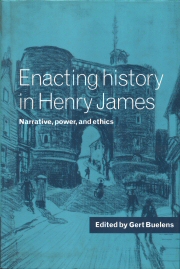Book contents
- Frontmatter
- Contents
- Notes on contributors
- Acknowledgments
- List of abbreviations
- Introduction
- 1 Power relations in the novels of James: the ‘liberal’ and the ‘radical’ version
- 2 Multiple germs, metaphorical systems, and moral fluctuation in The Ambassadors
- 3 James and the ethics of control: aspiring architects and their floating creatures
- 4 James and the shadow of the Roman Empire: manners and the consenting victim
- 5 ‘What Maisie knew’: Henry James's Bildungsroman of the artist as queer moralist
- 6 The double narrative of ‘The Beast in the Jungle’: ethical plot, ironical plot, and the play of power
- 7 Homoeroticism, identity, and agency in James's late tales
- 8 ‘A provision full of responsibilities’: senses of the past in Henry James's fourth phase
- 9 Possessing the American scene: race and vulgarity, seduction and judgment
- 10 History, narrative, and responsibility: speech acts in ‘The Aspern Papers’
- Index
3 - James and the ethics of control: aspiring architects and their floating creatures
Published online by Cambridge University Press: 02 February 2010
- Frontmatter
- Contents
- Notes on contributors
- Acknowledgments
- List of abbreviations
- Introduction
- 1 Power relations in the novels of James: the ‘liberal’ and the ‘radical’ version
- 2 Multiple germs, metaphorical systems, and moral fluctuation in The Ambassadors
- 3 James and the ethics of control: aspiring architects and their floating creatures
- 4 James and the shadow of the Roman Empire: manners and the consenting victim
- 5 ‘What Maisie knew’: Henry James's Bildungsroman of the artist as queer moralist
- 6 The double narrative of ‘The Beast in the Jungle’: ethical plot, ironical plot, and the play of power
- 7 Homoeroticism, identity, and agency in James's late tales
- 8 ‘A provision full of responsibilities’: senses of the past in Henry James's fourth phase
- 9 Possessing the American scene: race and vulgarity, seduction and judgment
- 10 History, narrative, and responsibility: speech acts in ‘The Aspern Papers’
- Index
Summary
In the Preface to The Portrait of a Lady, James explores a dialectic that shaped his paradoxical conception of his authorial role. Using a familiar trope, he likens the novel to ‘a structure reared with an “architectural” competence’ and calls attention to his powers as a master builder: ‘I would build large - in fine embossed vaults and painted arches, as who should say, and yet never let it appear that the chequered pavement, the ground under the reader's feet, fails to stretch at every point to the base of the walls’ (LC-II, 1080). But his characters, he suggests, enjoy a measure of independence: they ‘floated into [his] ken’ as if ‘by an impulse of their own’ and still resist the builder's efforts to contain them, even if his bricks are ‘scrupulously fitted together and packed-in’ (LC-II, 1081, 1083). Hence James's remark on the ‘latent extravagance’ of the novel as a genre, and hence his caveat that ‘I would rather, I think, have too little architecture than too much - when there's danger of its interfering with my measure of the truth’ (LC-II, 1075, 1072). Turning to Jame's notebooks, we can see that his efforts to reconcile form and freedom depend on the art of strategic omission. His entry on The Portrait of a Lady anticipates the Preface he wrote more than two decades later: Notice that James offers a dual defense of his experimental ending. On the one hand, it creates the illusion that Isabel's life extends beyond the text; and on the other, it contributes to the novel's formal unity.
- Type
- Chapter
- Information
- Enacting History in Henry JamesNarrative, Power, and Ethics, pp. 61 - 74Publisher: Cambridge University PressPrint publication year: 1997
- 2
- Cited by



